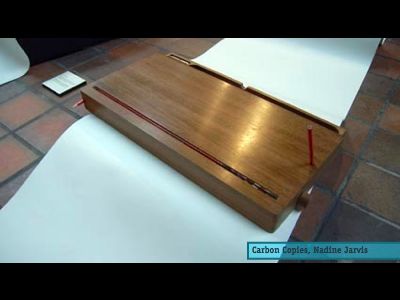The Hills Are Alive with the Sound of Interaction Design
I promised Jack and I would show some of our favourite things. This is the first. It’s the most moving project I’ve seen in a long while: Carbon Copies by Nadine Jarvis (photo by Matt Ward). It speaks directly to what I enjoy about closed systems.
It’s a pencil case. When a loved one dies, their cremated ashes are transformed into the graphite of 250 pencils. The pencil case is permanently closed. You can’t put more pencils in. You can see how many pencils are left, and take them out one by one.
As you use the pencils, to draw or to write, you’ll be thinking, naturally of whoever they’re from. Leaving a trace behind.
The pencil case has a pencil sharpener built into the side. The shavings, the left over bits, also go into the pencil case, and are also shut in there. You can’t get them out.
The pencils are gradually replaced by pencil shavings, filling the case, and you’re left with that and whatever you’ve created. It’s beautiful in many different ways.
It addresses directly life and death and the concept of closed systems. I love it because it’s gentle, and because it only makes sense when you consider it in use, when you consider the process of what it does.
If, instead, I’d described it as a wooden box to hold pencil shavings made out of your dead friend… well, you’d think it repugnant. I’m going to come back to the distinction between process and object repeatedly, over this talk.
...
So I’ve been thinking about death a bunch recently.
...
If anybody here is keeping a list of lines not to use when you’re giving design talks, there’s one for you. So I’ve been thinking about death a bunch recently.
But I have. Specifically about getting old.
Young people, everything they do is golden. Their ideas are always spot on and brilliant. When you’re young, you can rely on that brilliance and goldenness and everything you do is great.
But I’ve noticed, getting older, that I need ways to think about things. Approaches. Ways of thinking.
I’ve been doing some consulting recently where I go to a company for 2 days, and we have the brief on the morning of the first day and they say “We need the Big Idea!”
Then they shut me in a room on my own with a motorway outside the window and bean bags. And they leave me there for a day and a half. And I have to get on with it. I can’t rely on just having an idea, somehow. So what keeps me going, what gives me the ideas? Approaches. Ways of thinking.
And designing products, since that’s what I’m here to talk about, whether they’re online, or interfaces, or bits of plastic and electronics… What are the good approaches? What kind of things should we be designing? What’s current?
I’m going to be talking about an approach that really works for us, today.
